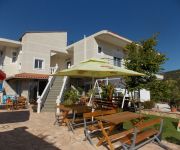Facts and Data
Webpages:
Official Unesco Page
Butrint (Albanian.com)
www.butrinti.org
Butrint, Albania (History Channel)
The Butrint Foundation
Basis Data:
Unesco World heritage since: 1992
Size of heritage:
- Buffer zone: 8,591 ha
Coordinates:
Longitude: 20,026°
Latitude: 39,751°
Summary
Inhabited since prehistoric times, Butrint has been the site of a Greek colony, a Roman city and a bishopric. Following a period of prosperity under Byzantine administration, then a brief occupation by the Venetians, the city was abandoned in the late Middle Ages after marshes formed in the area. The present archaeological site is a repository of ruins representing each period in the city’s development.
Location on Map
Show bigger map on Openstreetmap
Introduction
Butrint is an exceptional UNESCO World Heritage site located in the District of Sarandë, within the County of Vlorë in Albania. This ancient city holds immense historical and archaeological significance, dating back to the 7th century BC. Today, Butrint stands as a testament to the rich cultural heritage of Albania and attracts visitors from around the world.
History
The history of Butrint is a tapestry woven with the threads of various civilizations that have left their mark on this site. The city was initially settled by the Illyrians, an ancient Indo-European people, who established a thriving trading center. In the 4th century BC, Butrint came under the influence of the Greeks, who expanded the city and built impressive structures, including a theater and a sanctuary dedicated to Asclepius, the Greek god of healing.
During the Roman period, Butrint flourished as an important port city and became a significant part of the Roman Empire. The Romans constructed a forum, public baths, and a basilica, transforming Butrint into a bustling urban center. However, with the decline of the Roman Empire, the city fell into decline and was eventually abandoned.
In the Middle Ages, Butrint experienced a revival under the Byzantine Empire. The city became a bishopric and witnessed the construction of a baptistery and a cathedral. However, the Byzantine rule was short-lived, as Butrint was conquered by the Venetians in the 14th century. The Venetians fortified the city, adding defensive walls and a castle.
Over the centuries, Butrint changed hands multiple times, falling under the control of the Ottoman Empire and later the French. In the 20th century, the site was excavated and restored, revealing its remarkable historical layers.
Current State
Today, Butrint is a well-preserved archaeological site that showcases the diverse architectural styles and influences it has experienced throughout its history. The site covers an area of approximately 15 square kilometers and includes ruins from various periods, such as the Greek, Roman, Byzantine, and Venetian eras.
Visitors to Butrint can explore the remains of the ancient theater, which once hosted performances and gatherings. The theater, with its impressive acoustics and seating capacity of 1,500, provides a glimpse into the cultural life of the city. The Roman forum, surrounded by columns and adorned with intricate mosaics, offers a glimpse into the daily life of the Roman inhabitants.
The Baptistery of Butrint, a Byzantine structure, is another highlight of the site. This octagonal building, adorned with beautiful frescoes and marble decorations, served as a place of Christian worship. The Venetian castle, with its imposing walls and towers, offers panoramic views of the surrounding landscape.
Butrint is not only a treasure trove of architectural wonders but also a haven for biodiversity. The site is home to a diverse range of flora and fauna, including rare species. The surrounding wetlands and lake provide a habitat for numerous bird species, making Butrint a paradise for nature enthusiasts.
Conclusion
Butrint stands as a testament to the rich history and cultural heritage of Albania. This UNESCO World Heritage site offers a captivating journey through time, allowing visitors to explore the remnants of ancient civilizations. With its well-preserved ruins and stunning natural surroundings, Butrint continues to captivate and inspire all who visit.
Hotels and places to stay
Hotel Chris
Agrume Inn
Videos from the area
Videos provided by Youtube are under the copyright of their owners.







